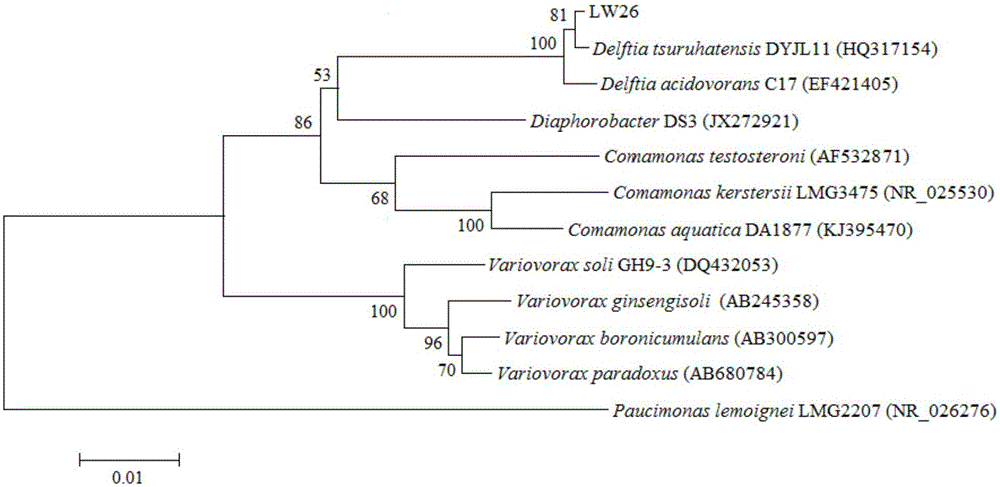Delftia tsuruhatensis LW26 and application thereof in chlorobenzene degradation
A technology of Delftia, LW26, which is applied in the direction of bacteria, microorganism-based methods, water/sludge/sewage treatment, etc., can solve the problem that Delftia has not been seen to degrade chlorobenzene, etc., and achieves fast degradation speed and tolerance concentration high effect
- Summary
- Abstract
- Description
- Claims
- Application Information
AI Technical Summary
Problems solved by technology
Method used
Image
Examples
Embodiment 1
[0032] Example 1: Isolation, purification and identification of Delftia LW26
[0033] (1) Isolation and purification of Delftia LW26
[0034] The biofilm on the packing surface of the bio-trickling filter tower was collected. This filter tower is a bio-trickling filter tower for the treatment of chlorobenzene waste gas in the Biotransformation and Bio-purification Laboratory of Zhejiang University of Technology. The inoculated activated sludge came from the sewage treatment tank of a pharmaceutical factory in Zhejiang. Stable operation for 5 months. After the biofilm was isolated and purified, a strain that could efficiently degrade chlorobenzene was obtained. Specific steps are as follows:
[0035] Take 5g filler from the biotrickling filter tower, wash the biofilm with 30mL sterile water in a shaker flask, place on a shaker at 160rpm, and shake at 30°C for 1 hour. Then use the inorganic salt medium containing chlorobenzene (the initial concentration of chlorobenzene is 10...
Embodiment 2
[0043] Embodiment 2: the preparation of Delftia LW26 bacterial suspension
[0044] When the amount of bacterial solution is small, the Delftia LW26 bacterial suspension can be obtained through three steps of inclined plane culture, seed culture and bacterial suspension preparation; The four steps of culture and bacterial suspension preparation are obtained, and the specific process is as follows:
[0045] (1) Slant culture: inoculate Delftia LW26 on R 2 A solid medium, cultivated at 28-32°C for 48 hours, to obtain slant bacteria;
[0046](2) Seed culture: pick an inoculation loop colony from the slope of step (1) and inoculate it into the seed medium, cultivate at 28-32°C for 24-36 hours, and obtain the seed liquid;
[0047] (3) Fermentation culture: inoculate the seed solution obtained in step (2) to the fermentation medium with an inoculum volume concentration of 5-10%, and cultivate it for 24-36 hours at 28-32°C and pH 6.0-8.0 to obtain fermentation broth;
[0048] (4) ...
Embodiment 3
[0049] Embodiment 3: Degradation characteristics of Delftia LW26 p-chlorobenzene
[0050] (1) Effect of temperature on the growth of Delftia LW26 and the degradation of chlorobenzene
[0051] The degradation experiment of Delft LW26 p-chlorobenzene was carried out at different temperatures, and it was found that it has a high ability to degrade chlorobenzene at 23-30 ° C. The specific experimental scheme is as follows:
[0052] Add 50mL inorganic salt culture medium to a 300mL shake flask, pH value 7.0, after sterilizing at 110°C for 40 minutes, add chlorobenzene as the only carbon source, so that the initial concentration of chlorobenzene is 100mg / L, then add 1mL of Example 2 Methods Delftia LW26 bacterial suspension (OD 600 = 0.15). During the experiment, three parallel samples and one blank control (without adding LW26 bacterial suspension) were designed for each temperature. Place each sample in a shaker at 23°C, 25°C, 30°C, 35°C, and 40°C for constant temperature culti...
PUM
| Property | Measurement | Unit |
|---|---|---|
| tolerance concentration | aaaaa | aaaaa |
Abstract
Description
Claims
Application Information
 Login to View More
Login to View More - R&D
- Intellectual Property
- Life Sciences
- Materials
- Tech Scout
- Unparalleled Data Quality
- Higher Quality Content
- 60% Fewer Hallucinations
Browse by: Latest US Patents, China's latest patents, Technical Efficacy Thesaurus, Application Domain, Technology Topic, Popular Technical Reports.
© 2025 PatSnap. All rights reserved.Legal|Privacy policy|Modern Slavery Act Transparency Statement|Sitemap|About US| Contact US: help@patsnap.com



